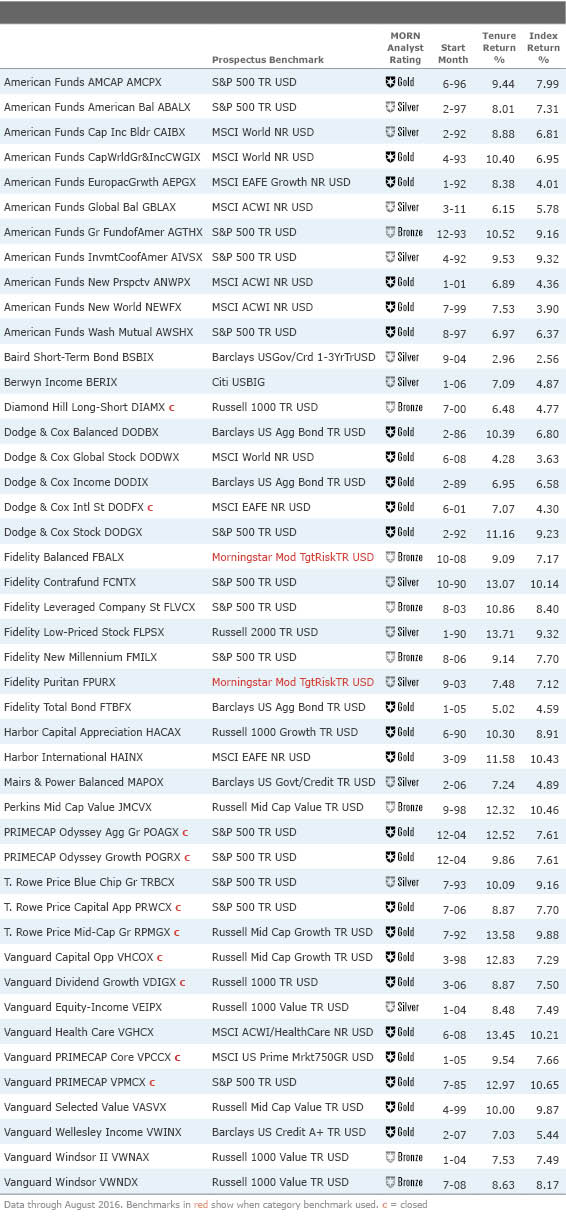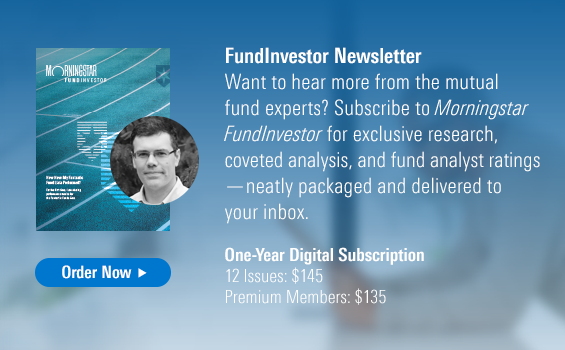Kinnel's Fantastic 45 Funds
Out of a universe of nearly 8,000 mutual funds, only these 45 passed Russ Kinnel's strict screen for fantastic funds.
This article first appeared in the July 2016 issue of FundInvestor. I have updated the data, and that resulted in three funds from the July list being removed for this version. Download a complimentary copy of FundInvestor by visiting the website.
It’s time once more for my annual screen for fantastic funds. The idea is to be very picky and very quantitative. I set up a list of key tests that I have for a fund and then see how many pass. This year, only 45 funds out of a universe of nearly 8,000 passed my tests. The rules are strict. I don’t let funds slide in just because they pass most of the tests. They have to pass all the tests. Here are the screens:
Cheapest quintile of category. Morningstar studies show that funds in the cheapest quintile of their Morningstar Category are a much better bet than the rest of the investment world, so this is the first test.
Manager investment of more than $1 million in the fund. We found that funds where at least one manager has invested more than $1 million of his own money are more likely to outperform than those without such alignment of interest.
Morningstar Risk rating below the High level. Our Morningstar Investor Return studies have found that highly volatile funds are much harder for investors to hold, and investor returns tend to trail total returns.
Morningstar Analyst Rating of Bronze or higher. This fundamental, forward-looking rating factors in qualitative and quantitative measures.
Parent rating of Positive. You want a good steward with a strong investment culture when you invest for the long haul.
Returns above the fund's benchmark. The best time period for looking at a fund is the manager's tenure rather than a standardized time period. So, I start with the earliest start date of the managers on a team and insist that the fund beat the benchmark over that time period. I used returns through August 2016. There is a minimum five-year manager tenure, too, to weed out those with less meaningful track records.
One new wrinkle this year is that if I thought a fund’s prospectus benchmark was a bad fit or if we didn’t have the benchmark’s track record far enough back, I opted for the category benchmark. This was mainly done to address the fact that many balanced funds have one equity benchmark and one bond benchmark rather than a blend of the two. That means they have either a very high or very low bar depending on which was the primary benchmark. Our category benchmarks are blended mixes of stocks and bonds, which make them a better fit.
Finally, I throw out institutional share classes to help you get a list you can use. (There are three funds with “institutional” in their names but minimum investments of $25,000 or less, which I don’t consider institutional.)
I didn’t exclude closed funds because many people still own them and would welcome confirmation that they are on the right track.
We have eight newly fantastic funds that were not on the list last year and I will highlight here.
Newly Fantastic
American Funds Capital Income Builder
CAIBX
This fund is back on the list after spending a year on the outside. Its expense ratio had bounced up to 0.62%, but now it is down to 0.59%, which gets it into the cheapest quintile and back into the Fantastic 45. The Silver-rated fund is in American’s sweet spot as the team is adept at generating income without taking on too much risk. The fund has about 80% of assets in dividend-paying stocks and the rest in bonds and cash. Assets are rather evenly split between the U.S. and overseas markets. Seven of the fund’s managers have committed more than $1 million of their own money to the fund.
American Funds Global Balanced GBLAX
This fund makes the Fantastic 45 in its first year of eligibility. Launched in February 2011, the fund targets a 60/40 split of global stocks and global bonds. It is run by three balanced managers, one equity specialist, and two bond specialists. The balanced managers have latitude to adjust their bond/stock mix. So far, it has gone nicely as the fund has handily beaten peers and modestly beaten the MSCI All-Country World Index. It is already up to $11 billion under management.
Baird Short-Term Bond BSBIX
This fund has a $25,000 minimum for institutional shares, but I think it is worth including despite the fact that it calls itself institutional. Baird’s M.O. is to have straightforward well-run funds that avoid big risks. While other bond managers are throwing in all manners of exotic exposures, this fund is plain-vanilla. If you want to avoid both credit and interest-rate risk, this is a good choice.
Diamond Hill Long-Short DIAMX
This fund is closed, so it can only go on your watchlist, not your buy list. The fund builds on the firm’s strengths in constructing great long equity portfolios and adds a short portfolio that is essentially the least attractive stocks as measured by its bottom-up value process. We rate Diamond Hill’s long portfolios Gold and this fund Bronze because the short side has not yet impressed us as much as the long side.
Fidelity Balanced FBALX
My secondary test of beating a category benchmark helped this fund get in. The Silver-rated fund has a 7.5% annualized return compared with 7.1% for the Morningstar Moderate Target Risk Index since October 2008 when the fund adopted a sector-specialist format headed by Bob Stansky. The fund keeps sector weightings in line with the S&P 500’s so that the fund has predictable exposure and stock selection can shine through. That part has been decent but not great. It’s the fixed-income side run by Ford O’Neil and Fred Hoff that we really like.
Fidelity Puritan FPURX
Fidelity Puritan also beat the Morningstar Moderate Target Risk benchmark, though its record goes back to September 2003 when Harley Lank started as manager of the fund’s high-yield sleeve. But more importantly, it has beaten the index and peers since lead manager Ramin Arani came on board in February 2007. Arani picks growth stocks for the stock-heavy fund, and he sets the fund’s allocation between stocks, high-quality bonds, and high-yield bonds. He’s made winning calls with stock selection and asset allocation.
Mairs & Power Balanced MAPOX
This fund is back on the list after a one-year absence. The fund’s expense ratio is right at the 20th percentile of its peer group, so it may forever be on the cusp of the Fantastic 45. Its returns, however, are well ahead of the category and prospectus benchmark since lead manager Ron Kaliebe was named comanager in January 2006. The strategy mixes stable-growing, dividend-paying equities with investment-grade bonds. It’s really an old-school balanced fund that can provide a pretty steady ride throughout a variety of markets.
T. Rowe Price Capital Appreciation PRWCX
This fund is closed, too, but I know that many people got in before it closed. David Giroux has done a remarkable job of stock selection and asset allocation. He uses a blue-chip growth-at-a-reasonable-price strategy for equities and then uses a little bit of everything for fixed income. The bond side includes high-yield, investment-grade, bank loans, Treasuries, and convertibles in an attempt to generate returns without taking on extreme risk. And, wow, the fund’s 8.8% annualized gain has beaten the Morningstar Moderate Target Risk Index’s 6.0% since July 2006 and even the S&P 500’s 7.7% return.



/s3.amazonaws.com/arc-authors/morningstar/fcc1768d-a037-447d-8b7d-b44a20e0fcf2.jpg)
/cloudfront-us-east-1.images.arcpublishing.com/morningstar/ZKOY2ZAHLJVJJMCLXHIVFME56M.jpg)
/cloudfront-us-east-1.images.arcpublishing.com/morningstar/IGTBIPRO7NEEVJCDNBPNUYEKEY.png)
/cloudfront-us-east-1.images.arcpublishing.com/morningstar/HDPMMDGUA5CUHI254MRUHYEFWU.png)
:quality(80)/s3.amazonaws.com/arc-authors/morningstar/fcc1768d-a037-447d-8b7d-b44a20e0fcf2.jpg)